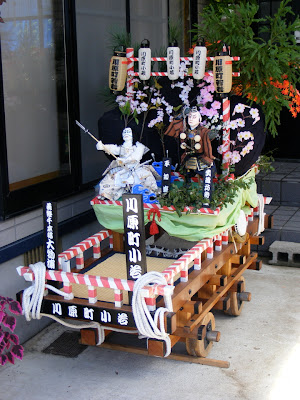荒海や
佐渡によこたふ
天河
ura umi ya
sado ni yokotau
ama no gawa
Turbulent the sea—
across to Sado stretches
the Milky Way
From Oku no Hosomichi. Exiles were once sent to Sado.
Matsuo Bashô (松尾芭蕉)
We stayed a couple of extra days in Kakunodate to watch the Hikayama Matsuri an annual festival in September, enacted in the Autumn to pray for peaceful times, suggestive of a safety valve to moderate their conflict-prone samurai past.
Each cart also has two teams of young girls in kimonos, on the front, who perform dances with fans and shawls, and inside each is a troupe of musicians with drums, flutes and Japanese lutes. The carts are pulled through a complex route around town with shouts of gusto and a great deal of heaving, every time the float has to make a change of direction.














The first evening all the floats were dragged to the major Shinto shrine Shinmeysa, where each team performed their songs and dances and ascended the steps to be blessed by the Shinto priests.























 Shinto Priests blessing the citizens Kakunodate
Shinto Priests blessing the citizens KakunodateThe next morning the priests did a round of the town in a parade of mobile shrines shaking paper fronds over each property and receiving offerings of prayers written on paper or fruit and other foods.









After the priests' round, all the floats began a morning and evening parade stopping at certain places where there were judges and other respected members of the populace, where they would again dance and sing and receive blessings.

 in the back was a band with drummers and samisen players
in the back was a band with drummers and samisen players




 with great gusto particularly when having to nudge the chariot
with great gusto particularly when having to nudge the chariotaround a corner or to do a display to the judges





The whole performance gave a fascinating insight into the way Japanese culture preserves a staunch image of itself and retains a sense of national and local identity through both cultural tradition and the role Shinto plays as a founding religion of culture. I'll come back to this again when we come to some later experiences.








At critical points on the parade route, each team would put on their best display of fan dancing and chariot presentation for the judges.































We missed the clashes between the chariots which must have been in the evening on the day we left.
 Here is a Wikipedia image of the same event a year later in 2008.
Here is a Wikipedia image of the same event a year later in 2008.


















0 件のコメント:
コメントを投稿